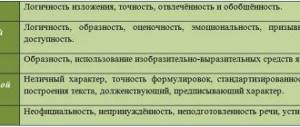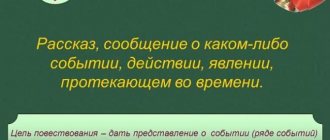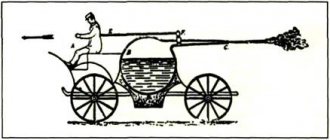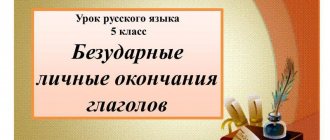Perhaps the title of this article will seem immodest to you, and the author - arrogant. You might think that the author used such a title to attract the attention of readers.
Yes it is. The purpose of this title is to draw your attention to the truly most effective way to teach a child the letters of the Russian alphabet in the shortest possible time and teach him to pronounce these letters with sounds. You will see for yourself the simplicity and effectiveness of this method by reading this article and starting to teach your child letters with its help. After just five lessons, your child will know all 10 vowels well and will begin to memorize consonants, even if he did not know a single letter before. And, most importantly, he will learn letters during games and remember them firmly.
But first, a little digression. Before you start teaching your child letters, you must decide why he needs it. Some parents are proud that they were able to teach letters to a two-year-old or even one-and-a-half-year-old child. But you should only do this if you also start teaching your child to read. Any knowledge must immediately find its practical application. But teaching letters by itself, without simultaneously learning to read, makes no sense. There are many other, no less effective, ways to develop a child’s memory and stimulate the brain during its formation. It’s good if, by the time he starts learning to read, the child will forget these prematurely learned letters and will not pronounce them the way he was once taught: Be, Ve, Ge... or Be, You, Gy..., otherwise when reading it will greatly interfere with him . You ask: “Well, if you teach a child letters and reading at the same time, then at what age is it better to start, from two years old?” I believe that at home, in the family, a mother with a child of this age can already study; but first for half a minute, and then for several minutes throughout the day. As a result of such “lessons”, built in the form of a game, the child will develop the ability to concentrate on some specific activity, and then, starting from the age of three and even a little earlier, he can be taught to read in a group of children like him. Just don’t forget that learning to read, especially early learning, should take place without coercion, in play, against a background of positive emotions.
A game method for learning ten vowels in 5 lessons
So, you have set out to teach your child to read books. You will, of course, start by learning letters with him. In what order should they be taught? Of course, not in alphabetical order and not in complete disorder, when the child is given vowels and consonants mixed up.
An important factor in the initial stage of learning to read by words is the child’s solid knowledge of the ten letters that represent vowel sounds (hereinafter, for simplicity, I will simply call them “vowels”). I have more than once drawn my attention to the fact that children who read poorly, even schoolchildren, hesitate to name vowels, and when reading they stumble, remembering whether it is E , or E , or Yu . In view of the paramount importance of knowing ten vowels for full reading (so that the child does not “stumble” in every warehouse), I developed this game technique for quickly learning them, which I have been successfully using for several years now.
The duration of each of the five lessons of this technique is several minutes. Lessons are held twice a week, and on the remaining days of the week, parents repeat the content of the previous lesson with the child for two to seven minutes a day. I calculated that teaching a child ten vowels using this method takes a total of just over an hour.
The methodology is based on the principle of repeated display and synchronous sounding of a group of symbols with their gradual partial replacement, proposed by the outstanding teacher Glen Doman. In this case, the task is made easier by the fact that in Russian vowels form pairs that seem to rhyme: A - Z, O - Yo, U - Yu, Y - I, E - E. I supplemented the multiple screening with five reinforcing games I developed.
- The goal of classes using this method is to give the child a solid knowledge of ten vowels in five lessons. Often, parents believe that their child does not need this: “He has known all the letters since he was two years old.” When you start showing him the letters, it turns out that he doesn’t know them well. He confuses E with E or Yu , does not know E , Y , sometimes thinks, remembering a letter. Before starting to learn to read, the child’s knowledge of all vowels must be brought to automaticity.
- From other ways of learning letters, which often only slow down their assimilation and make it difficult to use ( A - watermelon, I - turkey or O - like a donut, Y - Yulina's letter, I - looks like a post with a lantern, etc.), this technique is simple and effective.
Lesson No. 1: vowels a-z, o-e
Write or print the vowels on thick white paper, each on a separate card: the letters A, O, U, Y, E - in large bold red font on cards measuring 12x10cm, and I, E, Yu, I, E - in blue bold in slightly smaller font size on 9x10cm cards. In the first lesson you will only need cards A, Z, O, E.
| A | I |
| ABOUT | Yo |
On the back of each card, write this letter by hand for yourself, so as not to look at the front side when showing the letters to your child.
Classes can be taught by a teacher or one of the child’s parents.
Showing the first two pairs of vowels (A - Z, O - E).
Place two pairs of cards in a stack as shown in the left picture, with the back side facing you. A card closest to you forward (as indicated by the arrow in the right picture) and show it to the child. Say: “This is A. ” Then put the next card forward and say: “This is Me ”; then - “This is O ”; and then - “This is Yo .” Show each card no longer than 1 second. Make it fun, like a game. Look not at the cards, but into the child's eyes to see where he is looking and to attract his attention. Most children already know the letters A and O. You can pause and give the child the opportunity to name them himself. And quickly name the letters I and E yourself, before the child, so as not to give him the opportunity to make a mistake. And don't ask your child to repeat them. Your task is to quickly show these four letters and at the same time recite a small poem:
"This is A "
"It's me "
"It's about "
"It is "
Children can easily remember longer poems, and even more so, they will soon begin to repeat such an easy poem on their own.
If you are a teacher, explain to the child's mother present in class that she must show and name these four letters to him every day until the next lesson at least five times a day. Let her do this the first time in your presence so that you can correct her if she does something wrong. Do not hesitate to explain everything to parents in the same detail as to their children and check that they understand you. Shuffle the cards. Ask mom to put them in the right order. Then she must sit or stand the child in front of her and look into his eyes while showing the letters. She must pronounce letters unfamiliar to the child clearly and before him. A typical mistake is when mom takes out the next letter and holds it in her other hand, without covering the last letter with it. In this case, the child sees two letters at the same time.
Tell your mom that all her homework will take her half a minute a day, because... one such display lasts five seconds. It’s just important not to miss them. Gradually, the pause after the word “This is...” should be increased, and the word itself should be pronounced with a questioning intonation, as if encouraging the child to name the letters himself. The child must simply name the letter. He should not say “this is A ” or “the letter A ”. Give your mother the four letters you made and ask her to bring them with her to class.
Online Russian language lesson “Letters E, E, Yu, I”
11. In the picture below, color the large letter on the left and the small letter red. Shade the middle letter as shown. Find and color the letter E on the right.
12 . Connect with the letter E only those objects whose names begin with the sounds E.
13 . Underline the same letter as the one below on the left side of the picture. Circle all the E on the right side of the picture.
14. Complete the letter E. Cross out the letter that is different from the rest.
15. Color both letters red on the left side of the picture. Shade the letter in the middle according to the pattern. Find and color the letter E on the right side of the picture.
16. Connect with the letter E only those objects whose names begin with it.
17. Underline the same letter as below on the left side of the picture. Circle all the letters E on the right side of the picture.
18. Make the squares the same on the left. How are the squares on the right different?
19. Complete the letter E. Cross out the letter that is different from the rest.
20. Take a brown pencil and color in all parts of the drawing where the letter E
21.
E
and
Yo
are sisters. It is not easy to distinguish between sisters.
But the letter E
two dots, like a nail on a ladder.
Use a gray pencil to paint over all parts of the drawing with the letter E.
22. Game “Syllable Lotto”. Make up words with syllables:
le, re, e, lo, se, et, li, ka, sa, la.
Answer: fox, river, spruce, village, barks.
23. Game “Magic chain”. Change one letter.
Lotto – body; chalk - sat down - sang; village - solo - salo; river - hand; canopy - sleigh; sang - floor; Lena - moon; Senya – Sonya – Tonya – Tolya – Kolya – Polya; go - groan.
24. Game “Entertaining models”. Make up words using the following models:
- – e – (Chalk, forest, village.)
- e – – (Food, ate, ate.)
- e – – – (Raccoon, riding, ruffs.)
- – e – – (Lena, sat down, sang.)
25. Game “Shorty Babies”
| We are short babies. We will be glad if you think and find both the beginnings and the tails. |
Spruce-mel , tonnel , vermicelli , overcoat , Monday , strappy velvet , apel- sin , slit , bumblebee , drill , tsel , vestnyashka , hop , b spel e, bed spel , herring , pelmeni , gaz spel , miller , insole .
Food – bes food , medium food , m food , p food , res food , pob food , thorp food .
26. I gra “How many hedgehogs?”
Count how many times the combination of sounds “hedgehog” appears in the poem? Keep in mind that this combination of sounds can be hidden both in the middle and at the end of words
| He ran away from his friends without looking back. He said: “Look!” I’m playing hide and seek. First in the hole hedgehog took cover In onehedgehogke. Then he rolled into a ball According to the hedgehog . | Found under a birch treeCurls - grayhedgehogki.I decided to give them as a gift To the boy Serhedgehogke. So what is next? And then you will look. Where is the hedgehog ? Did you guess it? Yes, it's in the alphabet! A B C D E E F G H I... |
27. Igra “The word has crumbled.” All words must begin with the letter E.
Kizho, Sher, Chakolyo.
Answer: hedgehog, ruff, Christmas tree.
28. Game “Read the word.” Remember what an acrostic is. Read the word by adding the initial letters of the lines of the poem.
Yo lka, remember, under the grass
lived in a hole
And walked in needles,
Like a living Christmas tree. (Hedgehog.)
29. We write letters.
30.
Lesson No. 2: consolidation of vowel sounds a-ya, o-e
A, Z, O, E for two or three days after their mother and remembered them well in this order.
Reinforcing games.
Now with these four letters you need to play five reinforcing games so that the children firmly remember them both in the order of the learned rhyme and separately.
Place four cards in pairs on the table in front of the child, calling them out loud, in the order in which they were shown to him. After that, start playing games.
| A | I |
| ABOUT | Yo |
1st game. "Wind". Explain to your child that the red letters are big brothers, and the blue letters are little brothers. Then say: “The wind came and mixed up all the brothers.” Mix the letters yourself so they don't end up upside down. Then let the child put them in order in pairs, calling them out loud: A - next to I , O - next to E (at first with your help).
2nd game. "Hide and seek." Cover the smaller cards with larger ones (red letters on top) and change the order of these pairs: “The little brothers hid under the big ones and swapped places so that Helen wouldn’t find them. Guess which little brother is hiding under big brother O ? That's right, E is hidden O ! And under A ? That's right, I am !”
3rd game. "Hide and seek." You play the same way, but this time it’s the other way around - the big brothers are hiding under the little ones.
4th game. "Crow". Move your palms over the cards laid out in the correct order and say: “The crow flew, flew, flew, flew and... ate the letter.” Quickly cover one of the letters with your palm: “Which letter did the crow eat?” It is better to move both palms at the same time, so that it is more difficult for the child to guess which letter you are going to cover. If he was unable to answer quickly, remove your palm for a moment and cover the letter again. for example: “Next to O. That's right, Yo ! Over time, the child will remember the location of the letters and will guess them easily.
Game 5 "Cards". Now use the same cards to play with your child the same way adults play cards. You shuffle the cards, then throw a card on the table in front of him and ask: “What is this?” If you name it correctly - you win and take the card, if you make a mistake - another student takes it, and at home - your mother takes it. Don’t rush to allow other students to give you hints, let your child think a little. At first, try throwing cards in pairs: first O , followed by E , A - Z , etc. If the child wins confidently, throw in pairs, but in reverse order. Then start throwing randomly.
The mother present at the lesson remembers and writes down how to play these five games at home. You only need to play once a day, unless the child asks for more. But each time, stop the game while he still wants to play: “We’ll finish the game another time.”
Showing three pairs of vowels (A - Z, O - Yo, U - Yu).
After you have played five games with the first two pairs of letters, take out the next pair of cards you made U - U , write them on the back for yourself and add them to the pile (after the lesson, give this pile, all six letters, to your mother).
| A | I |
| ABOUT | Yo |
| U | YU |
Now show your child three pairs of letters the same way you showed him two pairs in lesson No. 1. Only this time the child names the first four letters, and you quickly name the last two yourself, not letting him make a mistake (remind your mother of this too). Give mom the same instructions as in lesson No. 1. By the next lesson, after two or three days of showing, the child will remember a new poem:
"This is A "
"It's me "
"It's about "
"It is "
"This is Y "
"This is Yu "
Give your mom these six letters you made and ask her to bring them with her to the next lesson.
Attention! After lesson No. 2, the mother shows the child these three pairs of vowels several times a day, but so far plays reinforcement games with him only for the first two pairs ( A - Z, O - E ) once a day.
Advertising
Study Materials
Poetry
* * * Next will be the letter E, I’ll show you that too. The tall spruce is growing. The hedgehog is chewing blackberries. Grandfather is riding in a cart. He turned one hundred years old. A raccoon lives under a bush. Egor goes outside. (V. Lomovtsev)
Poems about the letter "E"
Puzzles
* * * The raccoon chews, the raccoon chews, He chews blackberries, And on the pink wall He draws a letter...
Riddles about the letter "E"
Tongue Twisters
* * * The letter E rides on a mare across the grass with a spruce tree. It rides for several weeks, E brings the spruce tree to Elena.
Tongue twisters starting with the letter "E"
Fairy tales
Lesson #4: Consolidate all vowels
By the beginning of the fourth lesson, children know the following vowels in pairs: A - Ya, O - Yo, U - Yu, Y - I , and the letters A, Ya, O, Yo, U, Yu, thanks to reinforcement games, they also know scatteredly. need to consolidate their knowledge of the last vowels they learned Y and I.
Advertising
Reinforcing games.
You have already realized that the number of vowels with which we play reinforcement games increases with each lesson: in the second lesson we played with four letters, in the third - with six, and now these five games need to be played with eight letters.
Place the following eight cards in pairs on the table in front of your child, calling them out loud, in the order in which they were shown to him. After this, play the games detailed in Lesson No. 2.
| A | I |
| ABOUT | Yo |
| U | YU |
| Y | AND |




